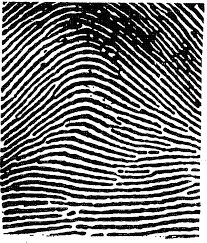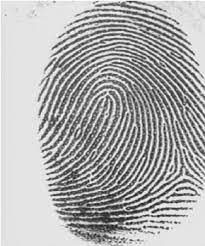The search method that doesn't have a formal geometric pattern or is easily definable
Link Method
Sometimes used in forensic cases to help determine the truthfulness of someone who may be connected to a possible crime.
Polygraph/Lie Detector Test
The name of someone that has just died
Decedent
A print left on a surface by the oils on one's skin, and such a print is not usually visible to the naked eye.
Latent Finger prints
The component of hair that gives it color. (cortex, medulla, or cuticle)
Cortex
The point in time when a person ceases to exist
Time of Death
The total number of blood type possibilities for humans
8
(A+, A-, B+, B-, O+, O-, AB+, AB-)
The outer most part of a hair
Cuticle
The equation for Time of Death
98.4-liver temp. divided by 1.5
Used on large, outdoor crime scenes. Searchers follow the first line pattern and search in the same manner as the line method. Once the first line pattern is complete, searchers realign on the other line pattern.
Grid Method
The physiological data that is measured while conducting a polygraph
Blood pressure, heart rate, respiratory rate, and skin conductivity
The name of the decedent in PLTW who has just died
Anna Garcia
Tiny fragments of physical evidence, such as hairs, fibers from clothing or carpeting, and pieces of glass.
Trace evidence
The place where an offense has been committed
Crime Scene
The blood type associated with agglutination in both the Anti-A serum and the Anti-B serum
AB
The part of the hair that is responsible for its color
Cortex
The condition after death where muscles stiffen caused by chemical changes in the body postmortem
Rigor Mortis
Used on large, outdoor crime scenes. Members of the search team are arranged at regular intervals, usually arm’s length, and then proceed to search along straight lines.
Line (or strip) Method
The type of questioning used at the beginning of an interrogation
Baseline (irrelevant) questioning: used as a starting point for comparison of physiologic behaviors of the person of interest
Signs, items, or material that supports, or corroborates a crime
Evidence
Finger print pattern that slopes up and down resembling a mountain

Arch
A type of evidence found on electronic devices that store data, such as computers, smartphones, or tablets
Digital Evidence
The reason why investigators draw a sketch of the crime scene to scale
It depicts the overall layout of a location and the relationship to evidence. Measurements need to be specific enough that they could recreate the scene, either digitally or in real life, for investigative purposes.
The blood type associated with agglutination in neither the Anti-A serum or Anti-B serum
O
The name of the muscle that makes it feel that it is "sticking straight up" or "standing on end"
Arrector pili
Condition of the body postmortem where blood pools on the dependent parts of the body due to gravity
Livor mortis
Used on crime scenes that are comprised of readily definable zones, such as in houses or buildings.
Zone Method
The types of questions a polygraph uses
Straightforward yes/no questions
Someone who law enforcement thinks may have information related to a possible crime.
Person of Interest
Finger print pattern where ridges curve to form a circular shape

Whorl pattern
Fingerprint patterns can change over time
(T/F)
False. Patterns don't change. Minutiae can.
The importance of knowing the crime scene ambient temperature.
To calculate time of death. Really hot and cold temperatures can affect decomposition rates.
The blood type that is the universal donor
O-
The name of the gland that secretes oil which strengthens hair and helps provide a protective layer
Sebaceous Gland
The condition of the body when the temperature cools postmortem
Algor mortis
Used on crime scenes with no physical barriers, such as open water. Can either begin at critical point of crime scene (outward spiral) or the outer-edge of the crime scene (inward spiral).
Spiral Method
The reason why polygraphs are not admissible in court
Not always accurate, some people can manipulate their responses
Branch of science that analyzes evidence for investigative purposes regarding criminal and civil matters.
Forensic Science
The amount of minutiae you need in common to be considered a match
12
The act of tainting, polluting, or defiling evidence
Contaminating
The person that conducts the autopsy of a deceased person
Medical examiner (Pathologist)
The blood type that is the universal recipient
AB+
The inner most part of a hair shaft. Can be absent with some hair types
Medulla
Term used to describe why someone died. Examples include homicide, suicide, accidental, natural causes. (most vague)
Manner of death
Search method used on small circular crime scenes
Wheel or ray method
The name of the measurements—specifically pulse rate, temperature, respiration rate, and blood pressure—that indicate the state of a patient’s essential body functions.
Vital signs
The importance of finding certain insects on a dead body or its eggs
Helps create or corroborate a timeline (time of death)
Fingerprints that are visible and left on smooth surfaces when blood, ink or other liquids come into contact with the hand and are transferred to a smooth surface.
Patent fingerprints
Blood test that reacts with hemoglobin and turns a violet color. Usually used on porous surfaces, such as a large stain on a carpet
LCV- Leucocrystal Violet
A function of white blood cells
White blood cells are part of the body's immune system. They help the body fight infection and other diseases.
The component of blood that helps with clotting
Thrombocytes or Platelets
The information about a particular person that exists on the internet as a result of their online activity
Digital footprint
Term used to describe what physiologically caused their death. (most specific)
Mechanism of Death
The professionals that examine the location, distribution, and shape of blood droplets, stains, puddles, and pools.
Blood splatter analyst
The name of the key on a crime scene sketch that has the date, time, location and temperature
Legend
Three-dimensional fingerprint impressions that can be made by pressing your fingers in fresh paint, wax, soap, or tar.
Plastic Fingerprints
This chemical/product glows bright blue in the dark when it comes in contact with blood.
Luminol
The two different types of blood identification tests
Presumptive and confirmatory testing
This blood type has no antibodies in the plasma
AB
The reason why we analyze hair at crime scenes even though it can't 100% positively ID someone
It can eliminate a person of interest
Term used to describe the event surrounding the death, such as gunshot wound, heart attack, fall...
Cause of death
Locard’s Exchange Principle
A theory that states that every time you make contact with another person, place, or thing, it results in an exchange of physical materials. This concept is referred to as Locard’s exchange principle, which hypothesizes that it is impossible for a criminal to act without leaving traces.
A fingerprint pattern where ridges curve back on themselves forming a particular shape

Loop
The most common presumptive blood test. This test uses a compound known as phenolphthalein, which reacts with the iron carried by hemoglobin
Kastle-Meyer
Liquid portion of the blood
Plasma
The relationship between height and blood spatter diameter
The higher the distance from the surface, the larger the diameter of blood
An oftentimes elected official who investigates violent, sudden, or suspicious deaths.
Coroner
The reason the hand-written note is important in the Anna Garcia case
Possible fingerprints, and analysis of the handwriting
Name two common minutiae
Ridge ending, fork, short ridge, dot, bridge, hook, eye, delta...
Anything that stimulates an immune response.
Antigen
This blood type has no antigens in the RBCs
O
Another name for white blood cells
Leukocytes
A physician, usually certified in forensic pathology, who is appointed to their position and performs autopsies.
Medical Examiner
The reason for wearing PPE at a crime scene
To protect yourself from bodily fluids, and to prevent contamination of the crime scene
A protein produced by B cells in the blood; works to impair pathogens. Also called an immunoglobulin.
Antibody
In an experiment, the group that the researcher expects to have a positive result, to show that the experimental setup was capable of producing results.
Positive Control
The protein in red blood cells that carry oxygen through the body
Hemoglobin